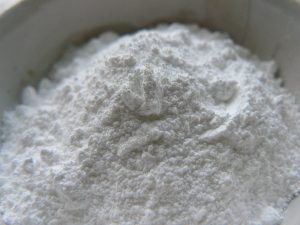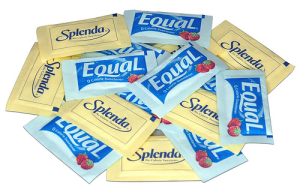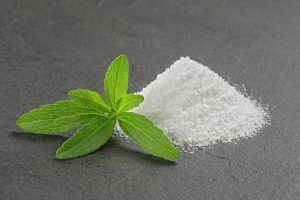Steviol glycosides market trend
With the background of global trend of reducing sugar, major food companies’ new product sugar-reduction programs have turned to natural sweeteners which is considered has a higher safety. Mintel’s data: In 2017, the developed new products contain Steviol glycosides grew 10%; and Steviol glycosides take part of 28% in foods and beverages that used high intensity sweeteners, a little higher than another high intensity sweetener – aspartame, which takes 25%.
Food and beverages that contain Steviol glycosides as sweetener are found all over the world, and the top two regions are Asia Pacific (40%) and Europe (22%), followed by Latin America, North America, and Middle East/Africa.
The ranked number of Steviol glycosides based products in 2017 were: snacks, juice drinks, dairy products, carbonated drinks and confectionery. From 2016 to 2017, the number of Steviol glycosides based foods and beverages developed specifically for children increased by 16%. Steviol glycosides market trend is gradually increasing.
Steviol glycosides tastes misunderstanding
Stevia glycosides are FDA-GRAS approved, zero-calorie, 150 to 400 times sweeter than cane sugar. The cost of using Stevia glycosides is 30-40% of sucrose at the same level of sweet. At the same time, Stevia glycosides can meet the international natural health trends. It is a good choice for health and sugar reduction.
However, at present, there are misunderstanding of the taste and the customers evaluation of Steviol glycosides in the market is not friendly. Even if the manufacturing process and technology have been continuously upgraded and the taste has been optimized, it still does not eliminate someone’s prejudice against stevia and Steviol glycosides.
Stevia extracts mainly contain 9 Steviol glycosides: Stevioside, Rebaudioside A, Rebaudioside B, Rebaudioside C, Rebaudioside D, Rebaudioside F, Dulcoside A, Rubusoside and Steviolbioside.
Its taste is related with the structure itself, but most perhaps the undesirable taste comes from the inaccuracy of the selected specifications from customers.
Generations of Steviol glycosides
First generation TSG series: recommended TSG95/RebA60
There are many specifications of Stevia glycosides and the taste varies greatly from one specification to another. Also, its taste performance in different finished products is sometimes different even if with the same specification. Food and beverage consumers have very high taste requirements for their product, so choose a best suitable steviol glycosides for their production is very important. In order to comply with international trends and meet the taste needs, we must have a very thorough understanding of the product’s application attributes.
According to taste requirements and optimization process of raw material production and purification process, steviol glycosides has the following generations and specifications:
- The First generation: Total Stevia glycosides (TSG) series, such as TSG95, TSG90, TSG85, etc.
- The Second generation: high purity monoglycosides, Stevioside, RebA, RebB, RebC, RebD95, RebM, etc., mainstream application specifications are like RebA 97%, RebA 99%
- The Third generation: mixed steviol glycoside, self-flavor modification scheme: RebA+RebB, RebA+RebC, RebA+RebD, RebA+RebM, etc.
- The Fourth generation is Stevia glycosides derivatives: glucosyl stevioside, such as GB2760 GSG75%, FEMA 4728 TSG80%, TSG95%, etc.
The first generation, we recommended TSG95/RebA60. Steviol glycosides are mainly used in domestic markets at the specifications of TSG85 and TSG90. Steviol glycosides contain the structure of hydrophobic stearyl groups such as -CH3 and -H; RebA, which has the highest sweetness and taste, the purity is not high enough in TSG85 and TSG90, and some of the minor glucosides component are bitter substances with hydrophobic groups, so there is a clear difference in taste with sugar.
With the increase of total Stevia glycosides content and purity of RebA, such as TSG85→TSG95/RebA60, the taste and sweetness have been significantly improved. Therefore, in the TSG series, TSG95/RebA60 is the preferred choice.
Regulatory reference: The United States FDA-GRAS used Stevia glycosides as a sweetener content standards require TSG ≥ 95%, JECFA standards also stipulated that stevioside used as a sweetener, the total Stevia glycosides content TSG ≥ 95%, international application examples in the solid drink, the TSG95/RebA60 is the product of choice for the majority of the threshold.
Second generation stevia monosaccharide, recommended RebA 97%~99%
Stevia glycosides in the natural composition of the leaves, Rebaudioside A (RebA) and Stevioside as the main components: RebA accounts for about 50% of the total Stevia glycosides in leaves, about 350 times the sweetness than sugar, taste is relatively pure. Stevioside accounts for about 30% of total Stevia glycosides, 180 times the sweetness, and its taste is not as good as RebA. Other mono-glycosides such as RebD, sweetness 350-400 times, taste better than RebA, but account for 1.2% of the total glycoside content or even lower. The RebM taste is comparable to sucrose, 350-400 times sweeter than the RebD.
Based on the demand for improved taste, high-purity refining and joint application from RebA → RebM has gradually emerged. Rebaudioside A (RebA) has become mainstream specifications for the stevia market due to thegood taste, commercial availability, and appropriate cost, with recommended specifications of RebA97% and RebA99%.
Third generation: high purity steviol glycoside combination
There is always a suitable for you with the in-depth development of steviol glycoside products, it has been found that when combined with different mono-glycosides such as RebA+RebB, RebA+RebC, RebA+RebD, RebA+RebM, etc., the taste of Reb A glycosides can be significantly improved and the price can also have advantages for some choices.
Fourth generation: Glucosyl Stevia
The introduction of some new glucose-based molecules into the structure of steviol glycosides by enzymatic or fermentation methods can improve the bad taste of natural steviol glycosides and give glucose-based steviol glycosides (Glucosyl Stevia) improved sweet taste characteristics. This technology has been used in Japan since the 1890s. Nowadays, the uses of glucose-based steviol glycosides as taste modifier or flavor enhancer is very mature in Japan and South Korea.
In China, glucosyl stevioside GSG75 was classified as a natural spice in the Health and Welfare Committee’s announcement No. 8 of 2016, and it was stipulated that it should be used as a spice in foods. In the United States, Glucose-based steviol glycosides TSG95 specifications can be used as tabletop sweeteners through the FDA-GRAS, and there are other specifications included on the FEMA-GRAS list for use as fragrances.
You can see that there are several generation and types of stevia products, commonly our sales of Rebaudioside A series, like RebA 97%, RebA 99% are higher than other types and specifications, we can understand from the market demand that the purity and good sweet taste is what our customers looking for and also their customers.
How to choose best suitable Steviol glycosides for your production is depends on your products requirement.




